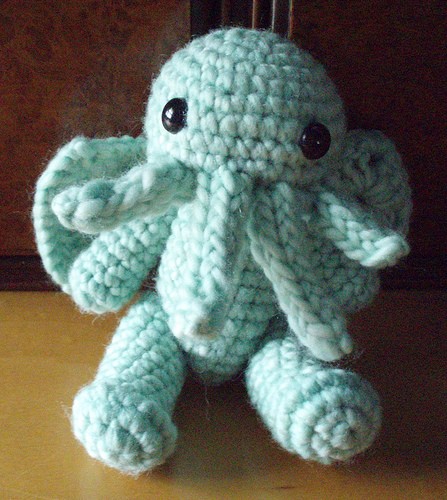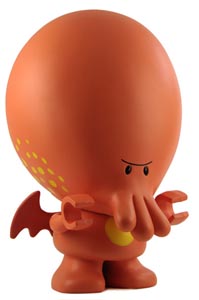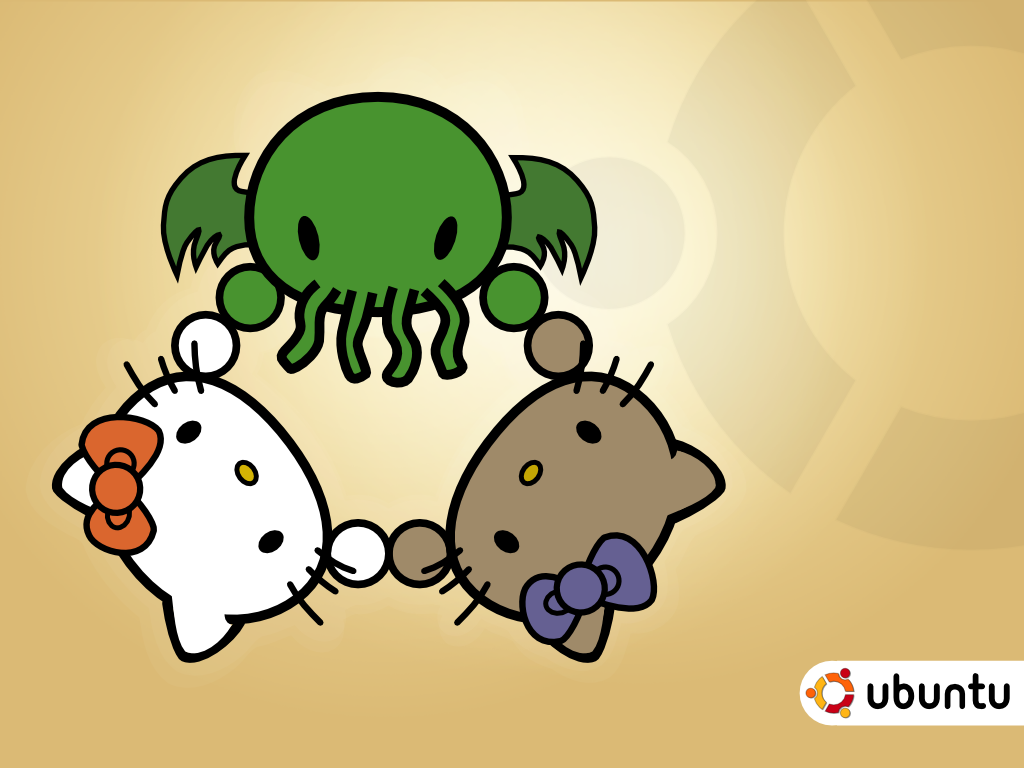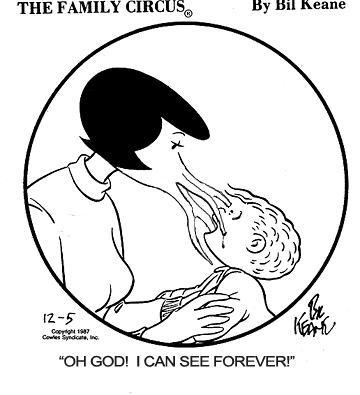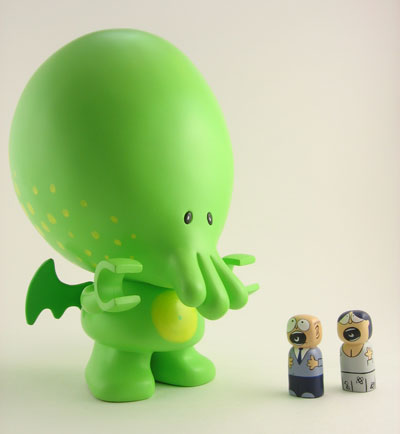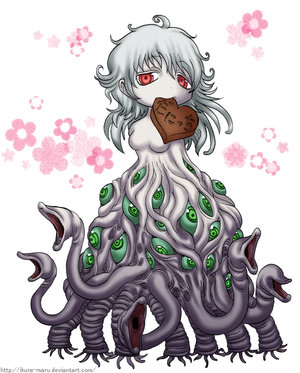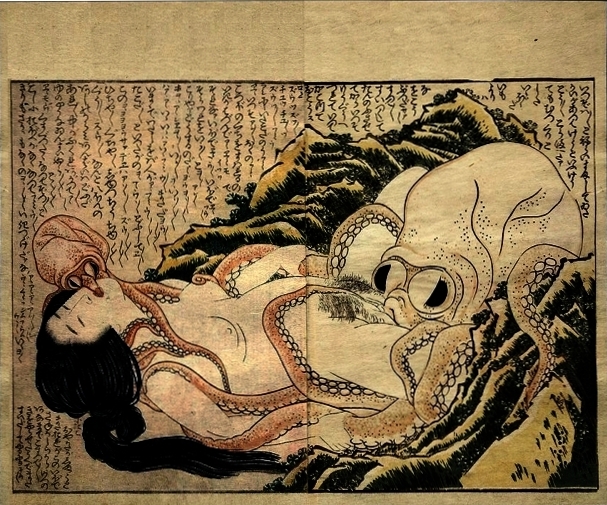
The most unsettling opening line in a horror story, I think, is the famous claim that launches H.P. Lovecraft’s 1926 tale “The Call of Cthulhu:”
The most merciful thing in the world, I think, is the inability of the human mind to correlate all its contents.
Because of this inability, Lovecraft’s narrator opines, our reality is equivalent to “a placid island of ignorance in the midst of black seas of infinity.” But the time of ultimate correlation is nigh—a time when, by piecing together the fragments of “dissociated knowledge” produced by the sciences, we will be thrust from that island into a vista of infinite reality that will so thoroughly eviscerate human meaning and purpose that we will go insane or flee into “the peace and safety of a new tea party.” Actually the phrase is “new dark age,” but you get the picture.
In this tangy bon-bon of nihilistic materialism, Lovecraft anticipates a peculiarly modern experience of dread, one conjured not by irrational fears of the dark but rather by the speculative realism of reason itself, staring into the cosmic void. Pascal was arguably the first to articulate this existential horror vacui when he proclaimed, in the face of the post-Copernican picture of an endless universe, that “the eternal silence of these infinite spaces terrifies me.” This terror before the empty and ultimately unknowable universe of scientific materialism is what gives the cosmic edge to the cosmic horror that Lovecraft, more than any other writer, injected into the modern imagination (though props must be given up as well to Arthur Machen, William Hope Hodgson, and, in the closing chapters of The Time Machine at least, H.G. Wells). While many secular people proclaim an almost childlike wonder at the mind-melting prospect of the incomprehensibly vast universe sketched out by astrophysics and bodied forth by doctored Hubble shots, Lovecraft would say that we have not really swallowed the implication of this inhuman immensity—that we have not, in other words, correlated our contents.
As an imaginative writer publishing in the pulps, Lovecraft peopled this meaningless void with squishy monsters—monsters whose unmatchable and perpetually resonant originality must, I believe, be traced at least in part to the particularly secular dread that animates them. (Vampires and demon dogs belong to the ages; Yog-Sothoth, Shub-Niggurath, and Cthulhu are ours.) Of course there is an immense difference between the equations that define Einsteinean space-time and the monotonous whine of accursed flutes that greet the seething nuclear chaos beyond angled space that is Azazoth, the blind idiot God. But Lovecraft’s genius was to suspend that difference, to, as it were, outgun Goya: it is not just the sleep of reason that breeds monsters, but reason with its eyes open and awake. The paradox, of course, is that too much reason evaporates the common sense of common human life, leaving us, once again, in the void of terrors. That’s why Lovecraft’s dialectic of scientific correlation is exactly mirrored in his fundamental narrative device: over and over (and over), readers of his stories watch his narrators slowly piece together fragments of lore and anomalous experiences into vistas of implication that reveal an unthinkable truth even as it drives them mad. (More critical readers will note how unconvincingly long his studious protagonists generally take to fit things together; I believe this is intentional, as it forces the reader into the position of one who already knows, for whom it is already too late.) Perhaps the most brilliant device in Chaosium’s Call of Cthulhu table-top role-playing game is the introduction of sanity points alongside the usual hit points. That’s the rub of all the scholars and investigators who populate Lovecraft’s tales: the more you study the Mythos, the closer you come to losing your marbles.
Nonetheless, at the risk of madness, we must study the anomaly at hand, that monstrous correlation known as the Cute Cthulhu: the chimeric fusion of Lovecraft’s obscene and infamous octopoid monster with that gooey, hard-wired mammalian sentiment now propagated through Japanimation, infantilizing design, and the spewing cute feeds of the Internet. Cute Cthulhu entered our dimension in force a decade ago, when Lovecraft’s “green, sticky spawn of the stars,” who even now lies dreaming in the sunken city of R’lyeh, transformed into a cuddly green plush toy designed and sold by a company called ToyVault.
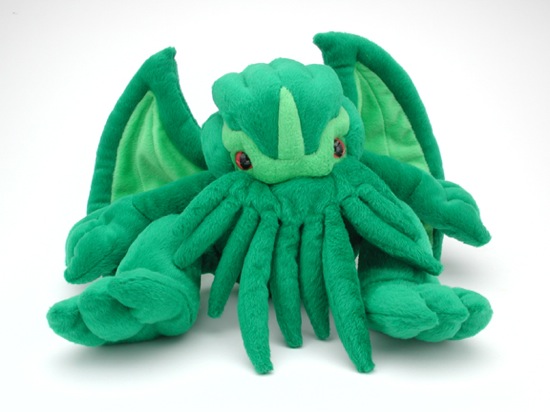
The company’s geek home run spawned a stream of mutations, including John Kovalic’s My Little Cthulhu vinyl toy, and various home-knitted “Love Crafts” on Etsy.
ToyVault in turn created a whole line of tentacled accessories, including waist pouches, hats, gloves, and slippers. Today about half the Chtulhu-themed shirt prints on Zazzle are cute, including “Sleepytime Cthulhu,” Baby Girl Cthulhu (“looks cute and evil”), and an infant creeper emblazoned with the phrase “the great cthulhu is my cousin.”
Along with multiple and largely unconvincing stabs at a tentacled Hello Kitty icon, a number of Lovecraft online comics go for the cute or at least goofy, most notably François Launet’s “The Unspeakable Vault (of Doom).” There is an entire memeverse devoted to “Pokéthulhu” alone: a freely distributed card-based game, figurines, and a web of fansites that sometimes include—in a postmodern echo of The Necronomicon, Lovecraft’s legendary imaginary grimoire—an episode guide to a Pokéthulhu TV show that does not, in fact, exist. At the same time, any number of actual cute Cthulhu videos can be turned up on YouTube, most notably the charming and wry short “The Adventures of Lil Cthulhu,” which begins with the following necromantic invocation: “It’s a new day and the stars are right. Wake up Lil Cthulhu!”
The Cute Cthulhu meme, which shows no signs of abating, slithers around within the general context of Lovecraftian parodies, like the Very Scary Solstice holiday album, the Cthulhu for President campaign (“Why choose the lesser evil?”), and the Miskatonic University t-shirt I bought when I was 14 and that still gets me fraternal nods at Neopagan gatherings. Such jovial nerd jabs are a staple of fan culture, of course, but they also reflect the unusual degree to which Lovecraft’s monster-haunted Arkham is an open source domain of the imagination. Even during his life, Lovecraft encouraged epistolary pals and fellow writers like Robert Howard and Clark Ashton Smith to propagate and invent elements of what Lovecraft sometimes called his “Yog-Sothothery.” Occasionally they would allude to one another with names that border on the cute—with Smith in mind, Lovecraft dubbed one Atlantean high priest Klarkash-Ton. Though the notion of a distinct “Cthulhu Mythos” was developed only after Lovecraft’s death by August Derleth—the writer’s systematizing St. Paul—the term does capture the palpable sense the Lovecraft built a meta-fictional frame of reference large enough to house the creative expression—or at least the in-jokes—of many other minds.
And so it has come to pass. Whether you think of his lore as a Mythos or not—the original tales themselves are littered with contradictions—Lovecraft is one of those rare writers to have achieved immortality not only as an author but as a genre originator. Thousands of authors, filmmakers, comic book writers and game designers have adapted and elaborated his narrative tropes, atmospheric imagery, and monster lore into an intertextual web that, like all realized genres, congeals into an archetypal reality more powerful than any specific instantiations of the material. Indeed, I suspect that it is partly the power of that intertextual web that helped make Fantasy Flight Game’s Arkham Horror table games and especially the Call of Cthulhu RPG such huge hits. “Come on in,” Lovecraft’s universe beckons. “The water’s foul.”
*
And still the dread conundrum: why and how did Cthulhu become cute? How did his eons-old awfulness become awwwwww….? Here is ToyVault’s Paul Blake, explaining the appeal of his company’s hit plushy to the Lovecraft News Network in 2009:
Cthulhu’s popularity specifically as a plush toy is down to a growing trend of postmodern deconstruction in media and culture in general. Cthulhu is a widely recognizable icon not just of Lovecraft’s work specifically, but of the Cosmic Horror genre as a whole — and by extension, an icon of undefinable fear, creeping madness, and abstract nightmares. Contrastingly, plush toys are an icon of the innocence of childhood, and all that is cute and cuddly. Merging the two creates a complete inversion of both of the concepts.
At least Blake recognizes that the postmodern parodies of fan culture alone do not account for the appeal of the cute Cthulhu. While some of the toy’s fans may simply fetishize irony, others, he suggested, might be responding to something more specific about the particular elements juxtaposed. “It comforts them to see an incomprehensible terror from beyond the reach of time reduced to cuddly, huggable teddy bear.”
It is nice to see a toy maker thinking hard, but I believe Blake is being too simplistic to see this particular correlation as a reduction of cosmic terror to cuteness, rather than a dialectical synthesis—or, perhaps, a batshit chaos. After all, it is arguably the very cutification of Cthulhu that renders the monster truly horrible. Why? Cthulhu, of course, is obscene enough on his own—not only are his or its rubbery tentacles and briny origins exhibit A in any Freudian reading of Lovecraft, but his very existence perverts the order of reality. But here is the great secret, my fellow mortals: cute is the true horror, the ultimate obscenity.
Part of this horrible obscenity lies in the ability of cute to undermine human reason and agency. The return of the Great Old Ones will reduce every human being unlucky enough to be alive to utter helplessness. But so too do we all become drooling sock-puppets of mammalian algorithms when confronted with furry exteriors, chirpy voices, disproportionately large eyes and heads, charming reductions of scale, and goofy facial expressions. Just watch heads turn in the grocery aisles as a particularly photogenic baby gets paraded by on the shopping cart, or watch your own heart melt when that little puppy with the velvety ears stumbles over a bone. Dig down far enough into this oogly-googly magnetism, and you will find yourself kneeling before the most depraved and nihilistic of gods: the abject.
Today, between the globalization of Japanimation and its cult of moe and the infantilizing idiocracy of so much popular design—to say nothing of the ubiquitous and unholy trinity of Camcorders, Baby Mammals and the Internet—cute is becoming king. As a media and design strategy, cuteness is pure virus—think of it as kitty poppers, or a sugar-coated net dragged through the dark waters of our Pavlovian unconscious. This raw infectious power is part of the horror, and reminds us of the virulence of Lovecraft’s own imaginative universe, which frequently manifests itself through narratives of memetic contagion. Lovecraft’s protagonists find out things no human should know; they are exposed to images or words from dreams or books that they can’t get out of their heads, that might even drive them mad. Indeed, part of the appeal of his work is the sense that, just as the monstrous truth of the human condition invades the minds of his protagonists through books and dreams, so too is this same reality, these same Old Ones, attempting to invade our own minds through Lovecraft’s “fiction.” Having exhausted the vectors of conventional horror fandom, perhaps Cute Cthulhu has become Their ultimate strategy, a self-replicating code of gibbering madness from the depths of space genetically implanted in a cuddly retrovirus. Did not ToyVault recently introduce a a new plush called Cthulhu the Wicked?
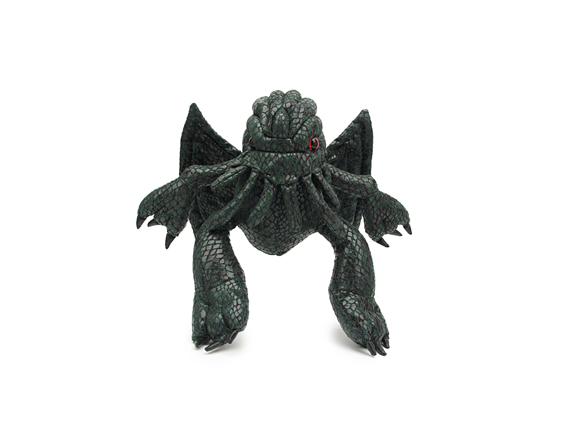
This scaly, red-eyed, and decidedly uncuddly commodity subverts the expected cuteness of the plush toy through a reappropriation of the bracketed horror of the original figure. It is, in other words, a return of the repressed. Far from being an ironic evacuation of cosmic horror then, Cute Cthulhu is actually a sign that these dread memes are growing even more infectious, that the Gate is Opening…
Excuse me, dear readers, I realize my thoughts are getting away from me. I should return to the facts of the matter. For our predilection for cute design lies in the world of facts—that is, in our own neural circuitry. We are hard-wired to find the proportional and behavioral characteristics of children—which define the template of cute—as worthy of comfort and protection; the addictive sugariness of our cute reaction helps offset all that feces and projectile vomiting, and is therefore good for the DNA. One can always be simplistic with such sociobiological explanations of course, and Japan’s peculiar and highly distinctive moe fetish reminds us that cute is always shaped by shifting cultural codes that keep the dream of “pure instinct” at a far remove. A case in point is the fact that it is easier for many of us to fawn over lion cubs or puppies—who share that same mammalian template—than more problematic human tots. But only the most idiotic constructionist would claim that our involuntary coos before bumbling toddlers or cavorting baby otters draw none of their juice from the genetic dynamo.
Indeed, at the risk of being obscene myself, I am tempted to declare that the closest cousin to cute media is actually pornography. As with porn, our reactions to cute media are often strong, immediate, compulsive, and—at the very least—keyed to biological imperatives and the psychoanalytic rhythm of repetition. (“That is not dead which can eternal lie.”) The involuntary intensity of the cute reaction is a clue; I have heard addicts of various cute feeds on the Internet (like Cute Overload or The Cute Project) refer to their fare as “cute crack.” Indeed, I would argue that the cutification of contemporary culture is actually the reverberant inverse of its increasingly explicit sexualization. Socio-biologically, the effects of arousal triggered by cute media and sexually explicit images might even be said to be two sides of the same apparatus of capture.
And now the dread conundrum of the cute Cthulhu begins to reveal itself, for one cannot consider the obscene correlation of cute media and porn without invoking hentai, the West’s catch-all term for that sexually explicit vein of Japanese manga and anime whose most monstrous manifestation is—yes, friends—tentacle porn. Like many commentators I cower before the alien mania of Japanese eroticism, and if there is a specifically anthropological light to be shed upon images of slithering octopoid monsters violating big-eyed Japanese lolicons in school uniforms, I cannot shed much. Early practitioners of the genre claim that the penetrating tentacle was simply a way to get around Japanese censorship of the penetrating cock, but this explanation belies the archetypal punch of the conjunction, not to mention its cultural antecedents. The invocation of Hokusai’s famous octopoid ukiyo-e “The Dream of the Fisherman’s Wife” is de rigeur here, and should suggest at the very least that hebephilic violation is not the only lens with which to understand this material.
After all, is not tentacle porn a psychoanalytically sassy image of human sexuality per se? In it we find the conjunction of a desirable imaginary cartoon with the polymorphous and slippery world of rubbery genitalia, whose uncanny multiplication into unnumbered tentacles invoke not only the alien and repetitive world of drive that lurks beneath sexual pleasure but the briny depths where human conception occurs. For did not Freud’s Hungarian comrade Ferenczi insist, in his mad Haeckel-inspired book Thalassa—published but a year after Lovecraft’s “Call of Cthulhu”—that the development of the human germ cell, from monoblast to fertilized egg through cuteness-facilitated dependence on the mother, is an ontogenic and hence psychologically persistent echo of the phylogenetic emergence of organic life on the planet earth? Is not intercourse itself not only a drive to return to the womb but to the ancient sea itself, where even now Cthulhu slumbers fitfully in the clammy climes of R’lyeh? Is not every act of intercourse therefore a ritual of his maddening return?
This horrible, unthinkable truth—that our own sexual desire is a vector of the return of the Great Old Ones—is only dimly reflected in the overt Lovecraftian references found in certain items of soft-core Japanese manga, like Eagle’s boring Moe Moe Cthulhu Mythos Dictionary or Kasakura’s Kowai to Kyôki no Cthulhu Shinwa (“The Terror and Madness of the Cthulhu Mythos”), a Lovecraftian artbook that has a cute girl on the cover. No no, dear readers, the ghastly, frightful truth of our condition, which even now tugs on my sanity, is only fully realized by the figure of Cute Cthulhu itself, because Cute Cthulhu is the spawn himself of the ill couplings depicted in tentacle porn—the dread, dialectical media child of cuteness and drive, the ultimate correlation…

